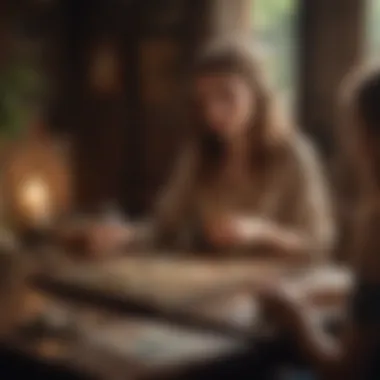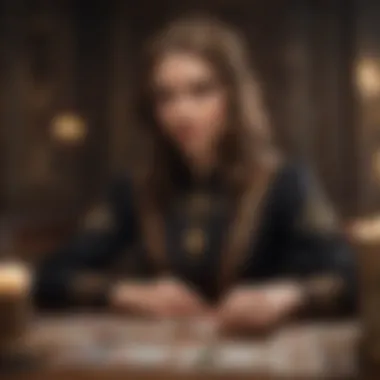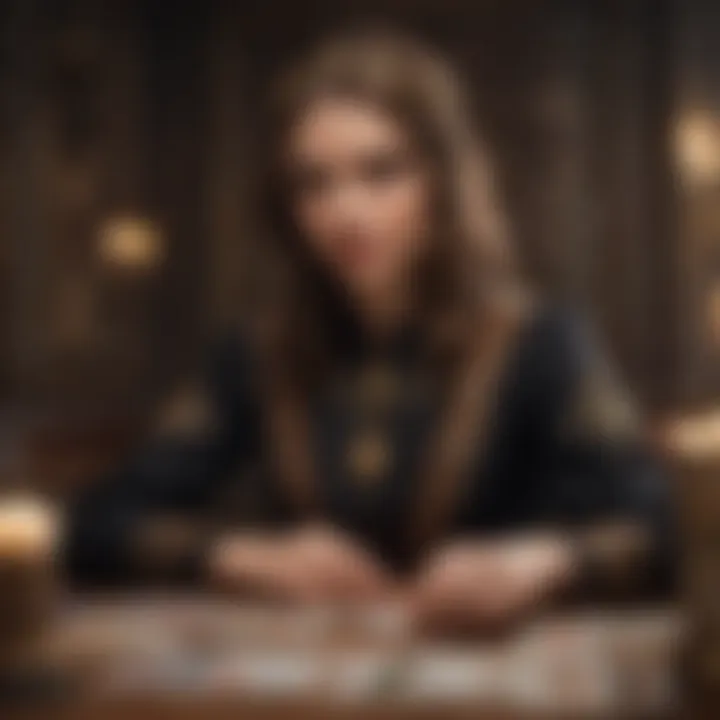Exploring the Impact and Features of Tarot Card Reading Apps


Intro
In recent years, there has been a notable surge in the popularity of tarot card reading apps. These applications serve as digital gateways into the world of tarot, providing users with convenient access to readings, guidance, and insights. Understanding how these apps work is essential for anyone intrigued by astrology and personal growth.
Zodiac Profiles
Overview of Each Sign
The zodiac consists of twelve signs, each with its own unique characteristics and symbolism. From Aries to Pisces, these signs narrate the stories of human experiences through celestial influence. Tarot apps often incorporate zodiac profiles, allowing users to further explore their astrological connections.
Personality Traits
Each zodiac sign embodies distinct personality traits. For instance, Aries is known for its leadership and passion, while Taurus stands for stability and sensuality. Understanding these traits can enhance the self-awareness of users. The apps often provide in-depth descriptions tailored for individual signs, helping users recognize their inherent natures.
Strengths and Weaknesses
Alongside personality traits, tarot apps frequently discuss the strengths and weaknesses linked with each zodiac sign. Knowing what these strengths are can motivate personal development. Meanwhile, being aware of weaknesses offers users insights into areas that may need attention or growth.
Compatibility Insights
Love and Relationships
Astrology heavily influences perceptions of compatibility in love. Tarot card reading apps often include sections dedicated to relationship insights, correlating zodiac signs to uncover romantic potentials. For example, a Libra may connect harmoniously with a Gemini, while a Scorpio may find challenges with an Aquarius.
Friendship Compatibility
Friendships, much like romantic relationships, can be analyzed through the lens of astrology. Understanding the dynamics between different signs can facilitate stronger friendships and communication. Apps typically demonstrate how different zodiac signs interact, thereby enhancing social connections.
Workplace Dynamics
The impact of astrology is not limited to personal relationships. It can also shape workplace environments. Tarot apps might include insights on how zodiac signs function together in professional settings. A sign like Capricorn might be diligent and committed, whereas a Sagittarius may thrive in creative and flexible roles.
Astrological Events
Monthly/Weekly Horoscope Breakdown
Many tarot and astrology apps provide horoscope forecasts, breaking down astrological trends on a monthly or weekly basis. This feature can aid users by guiding them in making informed decisions based on cosmic energies.
Notable Celestial Events
Alerts about significant celestial events, such as eclipses or retrogrades, are common features in these apps. Keeping track of this information helps users prepare for upcoming shifts that could influence their lives.
How to Prepare for Astrological Shifts
Each astrological event presents opportunities for growth and reflection. Tarot apps frequently offer advice on how to make the most of these cosmic occurrences. This includes practices such as journaling, meditation, or specific tarot spreads designed for introspection during these times.
Understanding the relationship between astrology and personal growth is crucial for utilizing tarot apps effectively.
In summary, tarot card reading apps serve as tools for personal exploration, combining astrological knowledge with tarot practices to cater to an ever-growing audience. Through features like zodiac profiles, compatibility insights, and astrological event tracking, users can engage more deeply with their spiritual journeys.
Prelude to Tarot Card Reading Apps
The rise of tarot card reading applications represents a significant cultural shift in how ancient practices are integrated into modern life. As technology continues to permeate everyday experiences, these apps serve a crucial role in making tarot accessible to a broader audience. They provide tools not only for divination but also for personal reflection and guidance. Understanding the impact of these applications helps illuminate their relevance in today's digitally-driven society.
Understanding Tarot Reading
Tarot reading, at its core, is a practice that has captivated individuals for centuries. Traditionally, the tarot consists of a deck of 78 cards, each rich with symbolism and meaning. The primary function of tarot readings is to provide insights into one’s life, helping seekers understand their past, make informed decisions, and contemplate their future.
The interpretation of tarot cards often depends heavily on the context of the question posed. Each card reveals different facets of the human experience, whether relating to love, career, or personal development. With the advent of tarot apps, users can engage with this intricate system at their own pace, tailoring their experience to fit personal needs and preferences. Thus, these applications serve as both a learning tool for beginners and a resource for experienced practitioners seeking convenience and innovation in their practices.
The Digital Transformation of Tarot
The digital transformation of tarot reading signifies more than just technological innovation; it represents a broader trend of integrating spirituality with technology. By providing tarot readings through apps, practitioners can reach people who might be hesitant to visit an in-person reader. Apps are designed to carry the intricate knowledge of tarot into an interactive and user-friendly format.
There are various features in these applications that cater to a range of user needs. For instance, some apps offer the ability to perform simple daily readings, while others provide detailed analyses with expansive card spreads and personalized interpretations. The ease of access brings tarot into more people's lives, thus demystifying the practice and enhancing its profile as a modern tool for self-discovery.
In summary, tarot card reading apps play an essential role in bridging traditional practices with contemporary lifestyles. They empower users, offering them the freedom to explore tarot on their terms. This transformation is vital for its potential to foster personal growth and assist in navigating life's complexities.
The Historical Context of Tarot
The exploration of tarot has deep roots in history, culture, and practice. Understanding the historical context of tarot is essential for appreciating its significance and transformation in the modern era. The journey of tarot from its origins to contemporary adaptations illustrates how cultural shifts influence spiritual practices. It also underlines the importance of historical knowledge when utilizing tarot card reading apps today. This section will delve into the origins of tarot cards and the evolution of tarot practices, providing a grounding for the subject matter presented in this article.
Origins of Tarot Cards
The origins of tarot cards are somewhat obscure, with debates surrounding their initial purpose and development. While some historians trace tarot’s beginnings back to 15th-century Europe, others argue that they have roots in ancient Egyptian or even Chinese traditions. The earliest tarot decks were designed as playing cards, closely linked to leisure rather than spiritual guidance.


Initially, these decks consisted of four suits, similar to modern playing cards, and included unique trumps. The introduction of symbolism was gradual, with icons gaining significance in occult practices over time. Key figures in the development of tarot include mystics and philosophers who integrated various esoteric traditions into their practices.
As tarot transitioned from a mere game to a tool for divination, its imagery became richer and more complex. Each card began to embody intricate themes of life, existence, and spirituality. This shift holds significance for modern users who seek insight and personal growth through tarot cards.
Evolution of Tarot Practices
The evolution of tarot practices highlights how this tool has adapted to societal changes. Throughout the centuries, tarot was primarily used by the elite and mystics. However, in the late 19th and early 20th centuries, it gained popularity among the general public, spurred by movements such as the Theosophical Society.
During this period, famous decks like the Rider-Waite were created, which solidified many of the associations we now recognize within tarot. The Rider-Waite deck, for example, incorporates dynamic imagery and themes, allowing for a more intuitive interpretation.
In the contemporary landscape, tarot practices have diversified. Many practitioners now combine tarot with psychology and self-assessment. Tarot reading apps have emerged, making these ancient tools accessible to a broader audience. While technology has reshaped tarot reading, it is essential to understand these developments through the lens of their historical context.
Understanding tarot's history enriches the experience of those who use modern tarot card reading apps, providing a deeper connection to the ongoing tradition.
The roots and evolution of tarot underscore how the practice has kept pace with cultural changes, reflecting a blend of tradition and innovation. As tarot continues to influence personal growth and self-discovery, its historical journey remains relevant for modern practitioners.
Features of Tarot Card Reading Apps
The world of tarot has dramatically altered with the arrival of mobile applications. This section explores the specific features that enhance user engagement and effectiveness of tarot card reading apps. Understanding these features is critical for anyone interested in the intricate blend of technology and spiritual guidance. Users can find a variety of functionalities that cater to their needs, making tarot practices more accessible and personalized. The emphasis here is on how these elements enhance user experience, promote learning, and support decision-making processes.
User Interface and Experience
The user interface in tarot card reading apps serves as the first point of interaction. A well-designed interface can enhance a user's connection to the material. It typically includes intuitive navigation, appealing graphics, and responsive design. A cluttered or confusing layout can deter users from fully engaging with their readings. Moreover, animations and sounds can deepen the experience, creating a more immersive atmosphere.
When users can interact easily with the app, the likelihood of regular engagement increases. Consequently, this routine can help foster a stronger connection between users and tarot cards. A smooth user experience encourages them to explore various card spreads, leading to greater insight and understanding.
Card Spreads and Interpretations
Card spreads form the backbone of tarot readings, directing the flow and focus of the session. Many apps offer various standard spreads like the three-card spread or the Celtic Cross. Furthermore, unique spreads, tailored to specific inquiries, can enhance user interaction.
Interpreting the cards is just as essential. Quality tarot apps provide comprehensive interpretations, often drawn from traditional sources. Users can benefit from detailed explanations of each card's symbol, positioning, and relationship to other cards within the spread. This feature is vital as it empowers users to generate meaningful insights from their readings.
Customization Options
Customization options allow users to personalize their tarot experience deeply. These functionalities might include selecting different decks, adjusting the layout of spreads, and even changing themes or backgrounds. Some apps enable users to adjust the reading context, which aids in aligning the reading with one’s zodiac sign or current emotional state.
The ability to tailor the experience makes each reading unique. Users feel a sense of ownership over their interactions, which can enhance not only satisfaction but also the perceived relevance of the insights gained. These options reflect the diverse needs of users, supporting individual journeys in personal growth.
"Customization empowers users to shape their tarot experience, making it feel unique and deeply personal."
Benefits of Using Tarot Card Reading Apps
Tarot card reading apps have emerged as instrumental tools in the modern exploration of astrology and spirituality. They bridge the gap between traditional beliefs and contemporary needs, providing users with a means of gaining insights and guidance at their fingertips. This section elaborates on the various benefits of using these apps, highlighting their impact on users.
Accessibility and Convenience
Tarot card reading apps offer an unparalleled level of accessibility. They bring the ancient practice of tarot into the digital age, allowing users to engage with it anytime and anywhere. This is particularly beneficial for those who lead busy lives or who may not have access to local tarot readers. Users can choose from a variety of readings and card spreads without waiting for an appointment. Additionally, many apps feature user-friendly interfaces, making it easy for both beginners and experienced practitioners to navigate.
The convenience of these apps extends to their ability to provide instant insights. Users can receive readings in real-time, enhancing the experience. For example, a person seeking clarity on a particular life event can draw cards and receive interpretations almost immediately. This immediacy can be comforting and affirming, thus enhancing the overall user experience. Overall, accessibility and convenience are cornerstones of tarot card reading apps, making them appealing for a wide audience.
Privacy and Anonymity
Another significant benefit is the privacy and anonymity that tarot card reading apps provide. Traditional readings often involve personal interactions, which may discourage some individuals from seeking guidance. In contrast, apps allow users to explore tarot without the pressure of face-to-face interactions. This level of discretion can be essential for people who are dealing with sensitive issues or who prefer to keep their spiritual practices private.
Moreover, many apps ensure that user data remains secure, allowing individuals to feel safer when accessing personal readings. By engaging with tarot in a private space, users may find a sense of freedom in articulating their thoughts and feelings, which can facilitate a more profound connection to the insights gained from the readings. Privacy and anonymity are thus vital advantages that make these apps an attractive option for spiritual exploration.
Learning and Development Tools
Tarot card reading apps also serve as valuable learning and development tools. Many offer resources to help users deepen their understanding of tarot, including detailed explanations of card meanings, various spreads, and interpretations. This educational aspect empowers individuals to gain knowledge at their own pace, fostering personal growth.
In-app journals and note-taking features allow users to track their readings and reflect on their thoughts over time. This can be particularly helpful for beginners who may feel overwhelmed by the complexity of tarot. Additionally, some apps may provide community features, allowing users to engage with others, ask questions, and share experiences.
“Learning through interaction with the app can enhance the reading experience, giving users the tools they need to interpret their own spreads effectively.”
The learning tools offered in these apps not only enhance the users’ understanding of tarot but also encourage the development of their intuitive skills. The integration of technology into tarot practices supports ongoing learning, making these apps a comprehensive resource for personal development.
Challenges and Limitations
Authenticity Concerns
In the realm of tarot card reading apps, authenticity holds significant weight. Users seek genuine experiences that reflect the depth and richness of traditional tarot practices. However, many apps may not offer accurate interpretations or represent the true essence of tarot reading. This raises doubts among practitioners about the legitimacy of the insights provided. Moreover, some algorithms used in app development can oversimplify complex tarot meanings, leading to misinterpretations.
A critical issue is that tarot is inherently a personal and intuitive practice, often relying on the reader's connection with the cards and the querent. With apps, this human element can be diminished or entirely lost. Users may encounter difficulties in relating to a machine-generated reading, questioning its relevance to their own life experiences. Furthermore, services that rely on user-generated content can vary widely in quality and cultural accuracy, which often leads to confusion.
To mitigate such concerns, users should do thorough research before committing to an app. Reviews on Reddit and platforms like Facebook can provide insights into user experiences and app reputations. An open dialogue about these issues within the tarot community can also promote greater awareness of the importance of authenticity in digital readings.


Over-Reliance on Technology
The convenience offered by tarot reading apps can be a double-edged sword. While they make tarot accessible to a wider audience, there is a risk of over-reliance on these technological tools. Many users might turn to apps for answers during times of uncertainty, neglecting the personal reflection and intuition that characterize traditional tarot reading. This can lead to an unhealthy dependency on technology for decision-making, rather than fostering one’s own inner wisdom.
Moreover, the ease of access to endless card readings can dilute the overall significance of each individual session. Users may find themselves conducting readings frequently without taking the time to reflect on the messages conveyed by the cards. This shift could undermine the seriousness and gravity that a physical tarot deck might command during a session.
It is essential to balance the use of technology with personal reflection. Users can approach apps as supplemental tools rather than primary sources of guidance. Engaging in self-study, journaling after readings, and participating in community discussions can keep the spirit of traditional tarot alive while benefiting from technological advancements. Ultimately, finding a harmonious relationship between humanity and technology will enrich the experience for those interested in tarot as a holistic life approach.
Ethical Considerations in Tarot Reading Apps
The rise of tarot card reading apps brings with it several ethical considerations that are important to address. The impact of these digital tools on personal guidance is substantial, and while they offer benefits, they also present challenges that require careful navigation. Addressing ethical issues ensures that users can engage with these apps responsibly and trust the information provided. The significance of informed consent and transparency cannot be overstated, as people engage with technology seeking clarity. Additionally, it is vital to manage user expectations effectively, which ultimately shapes their experience and satisfaction with tarot reading applications.
Informed Consent and Transparency
Informed consent is a key element in the use of tarot card reading apps. Users should be fully aware of how their data will be used, what methodologies the app employs for readings, and where the information may be sourced from. This transparency builds trust between the app developers and users. Users must understand the limits of the app's capabilities. Clarity around these points can dramatically affect user satisfaction and willingness to return.
- Clear descriptions of how readings are generated.
- Sharing data policies should be easily accessible.
- Transparency in the app's limitations can prevent misunderstanding.
By ensuring users give informed consent before engaging, developers foster a more ethical environment. Users who feel empowered to make well-informed decisions about their use of the app are more likely to have a positive experience.
Managing User Expectations
Setting realistic expectations is critical in enhancing user experience within tarot reading apps. Enthusiasts may look for deep insights or life-changing revelations, but it’s essential to clarify that tarot readings can serve as a guide rather than definitive answers. This distinction is vital to avoid disillusionment.
Some users may not realize that Tarot is often subjective and interpretative:
- Encourage a balanced perspective on the insights offered.
- Highlight the exploratory nature of tarot rather than guarantee specific outcomes.
- Provide disclaimers about the nature of readings, emphasizing they complement personal judgment and not replace professional guidance.
By openly communicating how tarot readings function, developers can help users maintain realistic expectations that lead to more satisfying interactions. This contributes to a healthier relationship between the user and the app, ultimately benefitting both parties.
Transparent communication and setting realistic expectations create a better user experience, fostering trust and satisfaction in tarot reading applications.
User Experiences and Testimonials
User experiences and testimonials serve as vital components in understanding the impact of tarot card reading apps. They offer insights into how these applications influence users' lives and whether they meet the expectations of those seeking guidance. By analyzing personal stories, potential users can better evaluate if these tools align with their needs.
User experiences often highlight the effectiveness of tarot apps in providing clarity and direction. Many users often find that the virtual nature of these platforms makes tarot card readings more accessible, eliminating geographical barriers. This democratization allows individuals from various backgrounds and cultures to engage with tarot in a way that might not have been previously possible. Furthermore, these experiences often reflect on the user interface and how intuitive the app’s design can be. When navigating these platforms feels seamless, users tend to report higher satisfaction and a willingness to recommend the apps to others.
However, experiences can also expose the limitations of tarot apps. Issues like technical glitches, overly complex features, or lack of genuine personal interaction may detract from the overall experience. These testimonials inform potential users about what to anticipate, prompting a more cautious and informed approach to selecting an app.
In short, examining user experiences and testimonials not only enhances understanding but also establishes trust in a market with numerous options. By considering both the positive and negative feedback, one can arrive at a more balanced perspective on tarot card reading apps.
Success Stories
Many users of tarot card reading apps have shared compelling success stories that underscore the potential benefits of these digital tools. For instance, some individuals recount instances where a specific card spread provided profound insights into their personal dilemmas. They often credit the app with helping them make pivotal life choices or navigate challenging emotional landscapes. By facilitating introspection and self-awareness, these apps can serve as catalysts for positive change.
Success stories often reflect a range of experiences. Some users speak about using these apps for daily guidance and finding that regular readings enhance their intuition. Others appreciate the chance to explore various spreads without needing a physical deck, tailoring their experience to fit their current situation.
Key Points in Success Stories:
- Personal Transformation: Users often cite improvements in mental well-being and clarity in decision-making.
- Empowerment: Many express feelings of empowerment and control over their circumstances after using tarot apps for insights.
- Community Connection: Some users note how these apps connect them with a community of like-minded individuals, enriching their overall experience.
Overall, success stories reveal the profound and varied ways that tarot card reading apps impact users, often encouraging exploration and growth in personal journeys.
Common Criticisms
Despite the positive feedback, common criticisms of tarot card reading apps emerge from user experiences. Some users express concern about the lack of human interaction. Traditional tarot readings often involve a reader’s intuition and interpersonal connection, which some apps may not replicate effectively. The digital medium can sometimes feel impersonal, leading to feelings of disengagement.
Technical issues are another frequent complaint. Users may encounter bugs, crashes, or slow-loading features. These obstacles can lead to frustrations and diminish the overall experience. Additionally, some individuals question the accuracy of the interpretations provided by the apps. There is a belief that without the context offered by a personal reader, the guidance may lack depth or be too generic.
Common Critiques Include:
- Impersonal Experience: Lack of emotional engagement compared to in-person readings.
- Technical Difficulties: Users often report bugs or crashes that can impair usability.
- Interpretation Concerns: Some believe that app-generated interpretations may lack nuance.
In summary, while user experiences are instrumental in revealing the benefits of tarot card reading apps, they also expose areas of concern. This balance of positive feedback and criticism is crucial for potential users to make informed decisions.
Comparison of Popular Tarot Card Reading Apps
The rise of tarot card reading apps represents a significant shift in how individuals engage with tarot and astrology. Comparing these applications is vital for users seeking tools that meet their unique needs. Each app comes with its own set of features, user experiences, and benefits, impacting how effectively users can harness the insights these cards provide. Examining popular apps allows potential users to select one that aligns with their preferences and intentions, enhancing their journey through tarot exploration.
App A: Features and Pros
App A boasts an intuitive user interface designed for ease of navigation. Users can quickly access various card spreads and insightful interpretations. Key features include:
- Educational Resources: Users can learn card meanings and spreads, making it ideal for beginners.
- Daily Card Draws: This feature encourages users to engage with their tarot practice regularly.
- Community Feature: Users can connect with like-minded individuals, enhancing their learning experience.


The positive user feedback often emphasizes the clarity of explanations and the supportive community aspect, making it a preferable choice for individuals wanting to integrate tarot into their daily routine.
App B: Features and Pros
App B is characterized by its extensive customization options. Users can tailor their tarot experiences according to their preferences. Notable features include:
- Customizable Decks: Users can select from various tarot decks, allowing personal resonance with the imagery.
- Advanced Interpretative Tools: Detailed interpretations and options for deep analysis cater to intermediate users.
- Integrated Journal: Users can document their readings and reflect on their journey over time.
This app appeals to those who prioritize personalized experiences. It allows for a deeper understanding of personal readings through greater customizability.
App C: Features and Pros
App C stands out for its unique blend of tarot and additional astrological insights. Its features include:
- Astrology Integration: This app offers features that connect tarot readings with astrological data, enhancing interpretations.
- Collaboration with Experts: Guidance from professional tarot readers is available within the app, providing expert insights.
- User-friendly Design: The layout is sleek and easy to navigate, even for new users.
Users frequently mention the value of combining tarot with astrology, feeling more connected to their readings. This app serves those seeking a holistic view of their personal growth.
Comparing tarot card reading apps equips users with knowledge to choose the tool that best complements their unique preferences, ultimately fostering a more meaningful tarot journey.
Integrating Tarot Reading with Other Astrological Practices
Integrating tarot reading with other astrological practices offers a broader understanding of the self and the universe. By combining these two methodologies, users can obtain richer insights and a more holistic view of their life's journey. This section will explore how tarot and astrology complement each other, illuminating their joint impact on personal guidance and self-discovery.
Tarot and Astrology
Tarot and astrology share common roots in ancient traditions that seek to connect individuals with deeper universal truths. While tarot uses a set of 78 cards with associated meanings, astrology relies on planetary positions and celestial events to interpret human experiences.
The intersection between these two practices can enhance personal readings significantly. For instance, both tarot and astrology address themes such as love, career, and spiritual growth, aligning their insights can deepen understanding. Many tarot readers incorporate astrological knowledge into their practices. They analyze the astrological implications of specific cards or spreads to offer more nuanced interpretations. As a result, users receive guidance that encompasses both their personal circumstances and the broader cosmic influences at play.
Moreover, combining tarot with astrology can help individuals identify recurring patterns. For example, if specific cards frequently appear during certain astrological transits, it may indicate a significant area of focus during that period. Leveraging both practices can empower users to make informed decisions aligned with their astrological cycles. This approach elevates tarot reading from mere fortune-telling to a profound tool for self-awareness.
Combining Tarot with Birth Charts
Integrating tarot reading with birth charts adds another layer of depth to personal insights. A birth chart, which illustrates the positions of celestial bodies at the exact moment of one's birth, provides a unique perspective on personality and life path. It reveals potential strengths, challenges, and opportunities. When readers use tarot alongside a birth chart, they can explore how the energies reflected in the chart interact with daily situations and choices.
For instance, an individual may consult their astrological placements related to career and then draw tarot cards to visualize potential outcomes related to job changes or projects. This integration allows users to interpret the cards in light of their astrological context, making the tarot readings more personalized and relevant to their current circumstances.
Benefits of this combination include:
- Enhanced Insights: Users can receive richer messages by correlating tarot interpretations with astrological insights.
- Personal Growth: Understanding astrological influences can guide deeper reflections during tarot readings, promoting personal development.
- Holistic Approach: Utilizing both practices invites a comprehensive view of life's challenges and opportunities.
- Informed Decision-Making: Users can benefit from a more profound clarity regarding choices and timing, grounded in both tarot and astrology.
By merging tarot reading with astrological practices, individuals can navigate their lives with increased awareness and intentionality, harnessing the wisdom of both disciplines for personal guidance and growth.
Future Trends in Tarot Card Reading Apps
The landscape of tarot card reading apps is constantly evolving, influenced by advancements in technology and changing user preferences. Understanding future trends is crucial for both developers and users. These trends can shape how individuals interact with tarot reading and enhance the overall experience. Considerations such as convenience, accessibility, and enriched user engagement will become significant in making these tools more appealing and effective.
Emerging Technologies
Emerging technologies play a key role in the development of tarot card reading apps. For instance, artificial intelligence is increasingly used to deliver personalized readings. AI algorithms analyze user data and preferences to provide tailored interpretations and spread suggestions. This creates a more customized experience, potentially increasing user satisfaction.
Moreover, augmented reality (AR) is anticipated to transform the way users engage with tarot. AR can create an immersive environment where users can interact with virtual deck cards in real-time. This kind of innovation can make the experience more engaging, as it blends the physical and digital worlds seamlessly.
Integration of voice recognition is also on the rise. Users may soon be able to conduct readings simply by speaking to the app. This hands-free experience allows users to focus more on intuition rather than technical aspects. As voice technology improves, its application in tarot reading becomes more viable.
Predicted User Trends
User trends reflect the changing expectations of tarot enthusiasts. A noticeable trend is the growing preference for community-focused features. Users often seek to connect with others to share experiences, insights, and readings. Thus, apps that incorporate social networking elements may gain a competitive edge.
Another emerging trend is the emphasis on mental wellness. More users are recognizing the therapeutic value of tarot. They will likely seek apps that offer features designed for personal growth and reflection. Tools that encourage users to journal their readings or provide guided meditative practices will appeal strongly to this audience.
Additionally, there is a shift towards sustainability in the creation of digital decks. Users may prefer apps that offer eco-friendly practices or support ethical sourcing of physical tarot decks. This aligns with broader societal values, influencing consumer choices in this space.
Ending: The Role of Tarot Card Reading Apps in Modern Astrology
Tarot card reading apps have become an intriguing facet of modern astrology, merging tradition with technology. This significant role they play not only preserves the essence of tarot but also adapts it to the contemporary needs and lifestyles of users. These applications provide a digital platform for individuals seeking guidance, introspection, or simply a deeper understanding of themselves and their circumstances.
Summarizing Key Insights
The convenience and accessibility of tarot reading apps cannot be overstated. Users can connect with their inner thoughts and emotions at any time, which encourages a personal approach to self-discovery. Key insights from the article highlight the following aspects:
- User-Friendly Interfaces: Well-designed apps enhance the user experience, making it easier for individuals, regardless of their familiarity with tarot, to engage meaningfully with the cards.
- Diverse Features: Options for various card spreads, interpretive tools, and customization allow users to tailor their readings to fit personal beliefs or preferences.
- Learning Opportunities: Many apps provide resources that help users deepen their knowledge about tarot, promoting not merely usage but also education and growth.
These elements demonstrate how tarot card reading apps serve as bridges between ancient wisdom and modern life, facilitating a deeper connection to astrological practices.
The Future of Tarot Reading
Looking ahead, the evolution of tarot card reading apps appears promising. Emerging technologies, such as artificial intelligence and augmented reality, may introduce innovative features. Users could expect:
- Personalized Experiences: AI could analyze users' past readings, offering customized insights based on their choices and patterns.
- Enhanced Visuals: Augmented reality elements could visualize card spreads in more immersive ways, enhancing the overall experience.
- Broader Integration: There could be more collaboration between tarot apps and other astrological tools, fostering a holistic approach to personal guidance.



